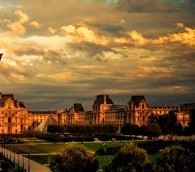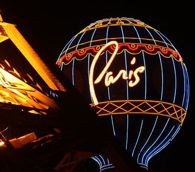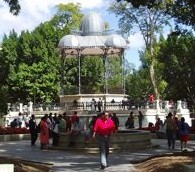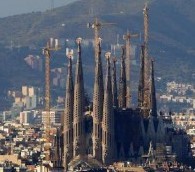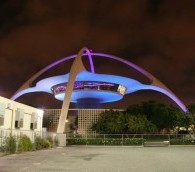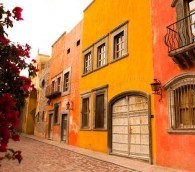Tag: Architecture
Moby on Los Angeles Architecture
by Jim Benning | 06.05.12 | 9:56 AM ET
People who’ve spent much time in Los Angeles know the city is home to some amazing architecture—classic mid-century designs, rustic Craftsman homes, bizarro medieval castles—and that these places are often tucked away in canyons, or behind tall fences, or in nondescript suburbs.
The musician Moby is now living in L.A., and he was so impressed by this that four months ago he launched a blog about it featuring his photographs and observations. It’s a good read. This short video offers an intro to L.A. architecture and his perspective on it:
‘Downton Abbey’ and the Art of the English Library
by Jim Benning | 02.02.12 | 3:17 AM ET
Like so many people, I’ve been glued to PBS’ “Downton Abbey” and the scheming and backstabbing unfolding in Highclere Castle. Here, series creator Julian Fellowes discusses his favorite room in the castle: the library. I love his take on it. The French have their drawing rooms. The Austrians have their ballrooms. Libraries, he says, are the rooms the English get right.
Watch Downton Abbey: Julian Fellowes on a Favorite Room at Highclere on PBS. See more from Masterpiece.
A Street Corner in Paris
by Jeffrey Tayler | 01.30.12 | 11:22 AM ET
Jeffrey Tayler had all but given up on the City of Light. Then he sat down at a Left Bank cafe.
Stilettos in Paris
by Eva Holland | 07.20.11 | 10:21 AM ET
Eva Holland did the Bohemian backpacker thing in Paris. Paris Las Vegas gave her the chance to act out a different role.
Democracy and the Zócalo
by Maya Kroth | 03.16.11 | 10:14 AM ET
As labor protests raged in Wisconsin, Maya Kroth found herself in Oaxaca, Mexico, getting in touch with American ideals
‘Ruin Porn’ in Detroit
by Eva Holland | 01.24.11 | 2:13 PM ET
In Guernica, John Patrick Leary takes a look at a couple of new books that depict Detroit’s empty urban landscape and ponders the broader trend they’re a part of.
So much ruin photography and ruin film aestheticizes poverty without inquiring of its origins, dramatizes spaces but never seeks out the people that inhabit and transform them, and romanticizes isolated acts of resistance without acknowledging the massive political and social forces aligned against the real transformation, and not just stubborn survival, of the city. And to see oneself portrayed in this way, as a curiosity to be lamented or studied, is jarring for any Detroiter, who is of course also an American, with all the sense of self-confidence and native-born privilege that we’re taught to associate with the United States.
(Via The Daily Dish)
Barcelona’s Sagrada Familia Consecrated After 128 Years
by Eva Holland | 11.08.10 | 1:03 PM ET
The Pope consecrated the Gaudi-designed church as a Basilica yesterday. The building is still unfinished—it’s been under construction since 1882—but the consecration means that daily masses can now be held in the main nave. If tourist entry fees remain steady, it’s hoped that the Sagrada Familia will be complete by 2026.
What was the World’s Tallest Building in 1884?
by Eva Holland | 10.08.10 | 3:09 PM ET
The Washington Monument. Kottke has a lovely graphic contrasting the monument with its 1880s competition. We’ve come a long way from the Mall to the Burj, huh?
Venice Faces Backlash Over ‘Grotesque’ Billboards
by Eva Holland | 10.05.10 | 3:16 PM ET
I don’t get it. Why would a city that’s banned shirtlessness, pushed back against souvenir vendors and fought a war against pigeons—all in the name of preserving the urban scenery—allow its most famous views to be obliterated by building-high billboards?
But that’s just what Venice has done, and the results are hideous. And the Mayor’s response to criticism over the ads? “If people want to see the building they should go home and look at a picture of it in a book.” Nice.
Illegal Pumping Threatens Angkor Wat
by Eva Holland | 09.28.10 | 4:35 PM ET
The Guardian’s Ben Doherty reports from Siem Reap, where the Angkor Wat temple complex is facing yet another threat. Doherty explains:
Unchecked development, and the widespread, unregulated pumping of groundwater throughout Siem Reap city, has raised concerns that the temples, including the world’s largest religious monument, Angkor Wat, could crack or crumble if too much water is drained away.
The temples and towers of the 402-square-kilometre Angkor site sit on a base of sand, kept firm by a constant supply of groundwater that rises and falls with the seasons, but which is now being used to supply a burgeoning city.
With the number of visitors to the northern Cambodian province approaching 2 million a year, increasing pressure is being put on the scarce water resource.
Thousands of illegal private pumps have been sunk across the city, pulling millions of litres of water from the ground each day.
There’s a report in the works that is expected to outline some possible water solutions for the area.
Las Vegas Bets on ‘Real’ Architecture
by Michael Yessis | 09.27.10 | 11:34 AM ET
Las Vegas, Paul Goldberger notes in the New Yorker, “has started to feel a little uncomfortable about its reputation as a place where developers spend billions of dollars on funny buildings.” That feeling helped inspire the latest over-the-top Vegas production. Goldberger writes:
The complex is called CityCenter, and it is the biggest construction project in the history of Las Vegas. It has three hotels, two condominium towers, a shopping mall, a convention center, a couple of dozen restaurants, a private monorail, and a casino. There was to have been a fourth hotel, whose opening has been delayed indefinitely. But even without it the project contains nearly eighteen million square feet of space, the equivalent of roughly six Empire State Buildings. “We wanted to create an urban space that would expand our center of gravity,” Jim Murren, the chairman of the company, told me. Murren, an art and architecture buff who studied urban planning in college and wrote his undergraduate thesis on the design of small urban parks, oversaw the selection of architects, and the result is a kind of gated community of glittering starchitect ambition. There are major buildings by Daniel Libeskind, Rafael Viñoly, Helmut Jahn, Pelli Clarke Pelli, Kohn Pedersen Fox, and Norman Foster; and interiors by Peter Marino, Lewis Tsurumaki Lewis, Bentel and Bentel, and AvroKO. There are also prominent sculptures by Maya Lin, Nancy Rubins, and Claes Oldenburg and Coosje van Bruggen. “The idea I wanted to convey was to bring smarter planning to the development process in Las Vegas, to expand our boundaries of knowledge,” Murren told me. “Las Vegas is always looked down upon. CityCenter is a counterpoint to the kitschiness.”
Goldberger doesn’t believe the project succeeds.
Chicago: The City Built by Geniuses
by Michael Yessis | 07.15.10 | 11:34 AM ET
Inspired by Justin Kern’s beautiful photos of the “University of Chicogwarts,” Roger Ebert has written a terrific post on Chicago architecture and the tension between beauty and commerce.
I walk around Chicago, and look up at buildings of variety and charm. I walk into lobbies of untold beauty. I ascend in elevators fit for the gods. Then I walk outside again and see the street defaced by the cruel storefronts of bank branches and mall chains, scornful of beauty. Here I squat! they declare. I am Chase! I am Citibank! I am Payless Shoe Source! I don’t speak to my neighbors. I have no interest in pleasing those who walk by. I occupy square footage at the lowest possible cost. My fixtures can be moved out overnight. I am capital.
Guggenheim Bilbao: ‘The Greatest Building of our Time’
by Jim Benning | 07.01.10 | 3:12 PM ET
Philip Johnson declared that of Frank Gehry’s iconic Guggenheim museum in 1998, and 52 experts polled by Vanity Fair just agreed.
Koolhaas on Museums and Their Impact on Cities
by Michael Yessis | 06.25.10 | 2:02 PM ET
Rem Koolhaas sat for an intriguing interview with Artforum that touches on museums’ influence on their communities. Here he is talking about the current state of Amsterdam and its big museums:
But Amsterdam is now a really interesting case, because it’s kind of a reverse Bilbao. They’ve closed two of Amsterdam’s major museums for eight years—the Stedelijk and the Rijksmuseum—both to be enlarged and “prepared for the twenty-first century.” The Van Gogh Museum has remained open, and recently the Hermitage opened a very successful satellite, but the effects of those two closures on the city are devastating. It’s lost its mission and its culture, and the absence really made the entire city suffer. The whole artists’ “scene” withered, because there were no major outlets you could hope to show in, nor outlets for systematic inspiration or interaction with significant art. In fact, it’s a very serious political issue: Simply the closure of two museums has diminished the status of the city internationally in a way that has many people dismayed and pessimistic about whether it might ever recover. So in some cases, you wonder whether “Bilbao” might actually be a necessity. It’s certainly legitimate for cities that aren’t “major” and have no “major” histories to try to use architecture to enhance their reputation, but when it’s being applied to the self-image of major cities like Rome and Moscow, it becomes counterproductive. It’s as if these cities are losing their confidence and self-respect.
(Via Coudal)
Of Great Buildings and Tourist Tchotchkes
by Jim Benning | 05.21.10 | 1:11 PM ET
Edward Hollis’s relatively new book—The Secret Lives of Buildings: From the Ruins of the Parthenon to the Las Vegas Strip in Thirteen Stories—is getting some good press. While a post in The New York Review of Books is worth a look, I most enjoyed coming across a 2009 review from the Guardian.
The LAX Theme Building: It’s (Almost) Back
by Michael Yessis | 04.19.10 | 12:52 PM ET
Three long years after shedding a 1,000-pound piece of itself, the iconic futuristic building at Los Angeles International Airport is almost ready for its adoring public again. Jennifer Steinhauer has the update.
Photo You Must See: One Amazing Puddle in St. Petersburg
by World Hum | 03.12.10 | 12:15 PM ET
St. Petersburg's Church of the Savior on the Spilled Blood is reflected in a puddle on the street
Photo You Must See: The Long Bridge to Sweden
by World Hum | 03.02.10 | 12:19 PM ET
The Oresund Bridge connects Malmo, Sweden and Copenhagen, Denmark
San Miguel de Allende: ‘The Loser Now Will be Later to Win’
by Peter Ferry | 02.19.10 | 10:34 AM ET
Peter Ferry celebrates a beloved Mexican city where you might not get all the avocados you want
Five Photos: The Painted Walls of San Miguel de Allende, Mexico
by World Hum | 02.19.10 | 10:23 AM ET
The historic Mexican city -- a haven for artists, writers and expats -- is as colorful as they come
- « Prev Page
- Next Page »
